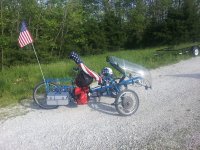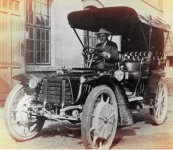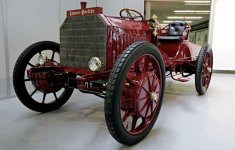To Do list:
In no particular order:
Add a mechanical stop to control the range of motion in the kingpin bearings. Right now, they can go overcenter and lock up. It isn' t a problem on the road, but is a problem when pushing the bike around. Could theoretically cause a dangerous wreck if it somehow happened at speed.
Add a reversing switch. There is a plug on each controller that reverses the direction of the motor. I could simple add a DPDT switch that would reverse both of them, allowing me to back up under power. Back out of the garage. Sweet!
Play with setting up the CA as a current throttle, instead of the configuration now where the throttle goes directly to the controller but the CA has a throttle override signal.
Tighten up the kingpin bearings. There is a lot of play right now, may have to shim something. Bike shop guy was looking at it, scratching his head.
Re adjust the toe-in
Add 12V distribution via a DC-DC converter.
Add a feature that runs all the lights from 12V. Currently, the lights all have separate batteries.
Upgrade to 1000 lumen LED headlights, ala motorcycle style. Currently, I have two 120 lumen bike style headlights. Might go with Justin's 1000 lumen headlights, or build something myself.
Add a 12V vehicle style accessory plug for 12V stuff.
Add a usb port that can charge my phone to the 12V system. This is not as difficult as it sounds.
Now that I have juice, add some tunes, powered from my smartphone. It would be sweet to be able to press a button and have the bike loudly proclaim
" It's Electric!".
replace some gear shift cables that aren't right. They work but need to be routed better, and are too short.
Fix the chainguard, so it protects my pants from grease, doesn't rub the pedal, but can allow the chain to be removed without going out of adjustment. Right now I can only achieve any 2 of those 3 goals.
build battery boxes/bags or what have you for the new batteries. The goal will be to have something that is removeable, but locks onto the bike when in use, both to prevent thievery and prevent jarring loose. Got to be watertight. I will probably include a padded spot for a charger, plus a stationary charger at home. People start gnashing teeth when I say this, but I have carried chargers in a foam lined box for thousands of miles without mishap.
Build a secure mount that holds my briefcase so it cannot fall off, but works without the current system of bungees.
Add a water bottle cage
get a better lock. Maybe a handcuff style lock to fix the wheel, then a cable style that can grab onto the nearest solid object. I hate keyed locks, I always lose the damn keys, but Kryptonite locks are usually keyed, so for now I have a stout combination cable lock only. This is a $5000 ride, it needs good locks.
add a small handlebar compartment for sunglasses, a snack, maybe wallet, etc
Get some soft and warm foam handlebar grips
add some thick rolls of foam padding to areas that I would strike in case of a head-on crash. Perhaps saw some crushable patterns into certain noncritical struts, so they would collapse in case of a crash instead of making me into a voodoo doll.
Add a switch that just runs WOT. Twisting a throttle for miles and miles gets old. This would be a sensitive dead-man style switch, that would go WOT if pressed all the way, so I can relieve my aching left throttle hand after 20 miles or so. Not sure how this will all work yet. Has to be hard to accidentally activate.
reconfigure the back rack. I am not satisfied with it's looks, I think I could build a lighter one that was just as strong, add a plate int he top that keeps the load from rubbing on the wheel. Add more points to attach bungees, for carrying odd loads.
It could do it, so why not: add footpegs so a passenger could ride the rear rack.
I wonder if there is a system that can track your bike if it is stolen? I have heard of such things, I will look into them. Seem to remember one that looks liek an innocent bike light, but can call your cell phone and locate the bike with GPS. This would be a fun hack to build.
Someday I'd like to build a bodystocking fairing - starting with a tailbox. This will become a higher priority as it cools off next winter. Got a sample of Stars and Stripes pattern Lycra on order. Also have some red, white, and blue nylon. Have sewing machine, will make body stocking.
Add pie pan wheel fairings to cover the spokes and make the wheels more aerodynamic, maybe make these out of coroplast. These must also be stars and stripes pattern and feature LEDs.
Strip off all the parts and paint it






